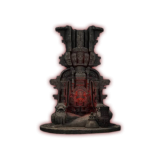PoE 2 Monk Guide – Complete Class Overview
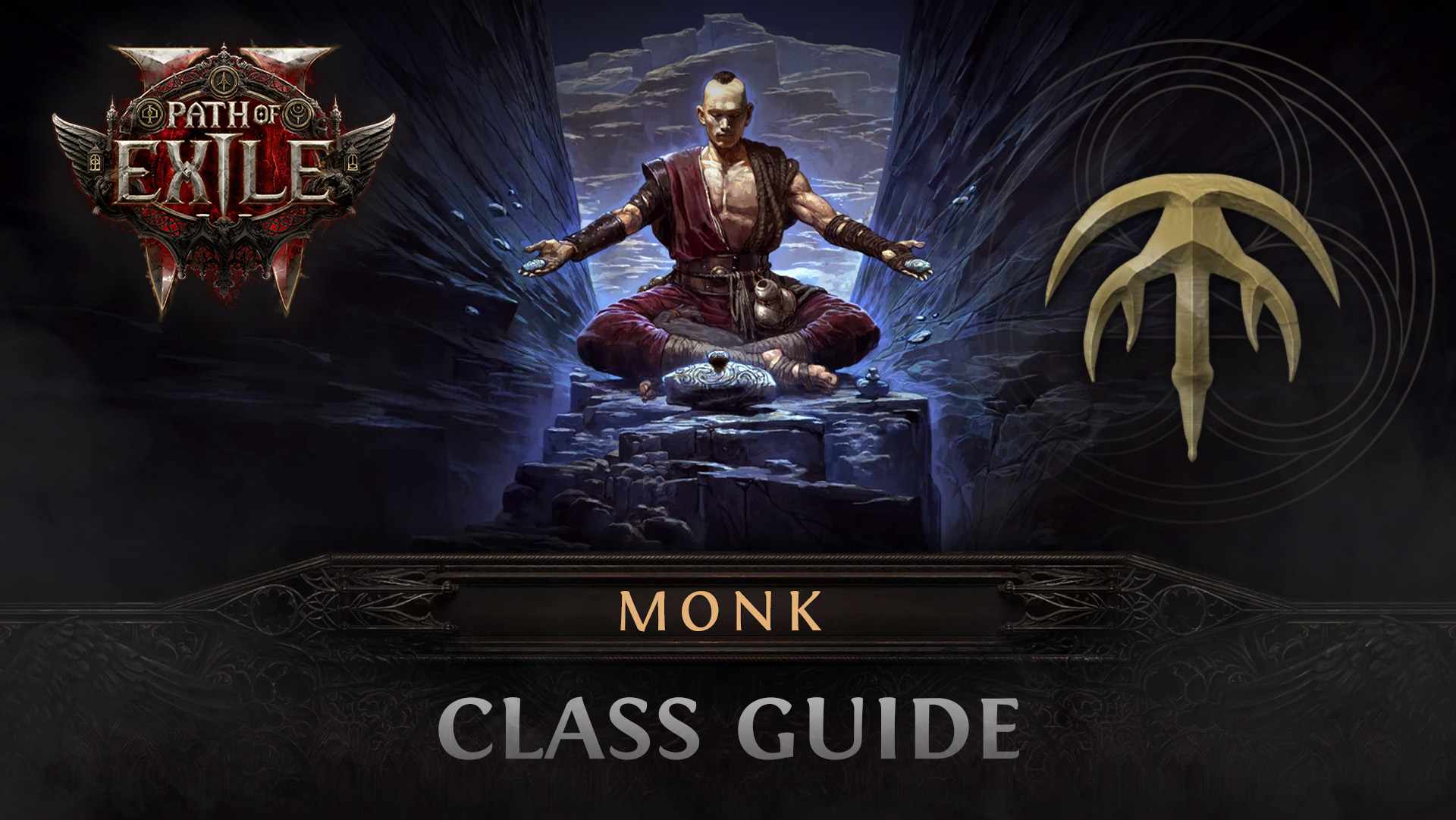
Introduction
Welcome to the ultimate guide to mastering the Monk class in Path of Exile 2!
Known for their versatility, speed, and devastating close-range combat abilities, Monks bring a unique blend of martial prowess and mystical power to the battlefield. Whether you're looking to obliterate your foes with rapid flurries of punches, incapacitate them with precise crowd-control skills, or harness spiritual energies to amplify your power, the Monk offers a diverse toolkit to suit your playstyle.
In this guide, we’ll explore what makes the Monk class a standout choice in PoE2. We’ll delve into their core mechanics, skill trees, unique abilities, strengths and weaknesses, optimal builds, and many more particularities. This guide will equip you with the knowledge to channel your inner warrior and achieve greatness as a Monk.
Get ready to unleash the Monk's discipline, power, and unrelenting focus - let’s dive in!
Table of Contents
In the following list, we present a little breakdown for our PoE2 Monk Class Guide:
- Class Overview
- Strengths and Weaknesses
- Stats Priority
- Monk Ascendancies
- Passive Skill Tree
- Best Monk Gems
- Monk Unique Items
- Monk Leveling Tips
- Monk League Starter Build
- Pro Monk Endgame TIps & Tricks
- FAQs
- Final Thoughts
Monk Class Overview
The Monk class in Path of Exile 2 combines martial arts prowess with divine energy, offering a disciplined and dynamic playstyle that excels in close-quarters combat. Monks unleash devastating combos with swift, fluid movement while maintaining exceptional mobility and crowd control. Their unique resource system and versatile skillset allow players to adapt to different challenges, whether focusing on raw melee damage, critical strikes, elemental effects, or a balance of offense and defense.
Monks are an excellent choice for players seeking a dynamic and fast-paced character with the potential for high damage output and survivability.
Class Archetype
The Monk archetype revolves around agility, precision, and spiritual power. Unlike heavy-hitting brute classes, Monks rely on finesse, utilizing a mix of unarmed combat techniques, weapons such as quarterstaff or fist-based gear, and supportive auras. Their key traits include:
- Speed and Agility: Monks boast high attack and movement speed, making them adept at dodging attacks and quickly repositioning in combat.
- Combo Skills: Many Monk abilities synergize to create fluid combos, rewarding players for chaining attacks effectively.
- Control and Versatility: Monks excel at stunning, slowing, or disrupting enemies while adapting their abilities to different situations.
- Hybrid Playstyles: Monks can mix physical, elemental, or even chaos damage into their arsenal, giving them flexibility in builds.
Class Resource
Monks utilize Focus as their primary resource. Focus is generated through various actions, such as attacking, evading, and using specific skills. It is consumed to unleash powerful attacks, activate defensive maneuvers, and enhance their combat abilities.
Damage Type
The Monk class is known for its diverse damage types, enabling players to customize their builds to suit different enemies and content.
- Physical Damage: Core to many Monk builds, physical damage is delivered through rapid melee strikes and area-of-effect attacks. Weapon or unarmed builds amplify this damage.
- Elemental Damage: Monks can infuse their attacks with fire, lightning, or cold damage, leveraging elemental effects to burn, shock, or freeze enemies. This adds utility and synergy with elemental modifiers.
- Chaos Damage: Some advanced monk builds incorporate chaos damage to bypass enemy resistance, making it effective against more challenging foes.
- Critical Strikes: Monks often focus on critical strike chance and multiplier to maximize burst damage, especially in high-speed builds.
Monk Weapons
In Path of Exile 2, the Monk class primarily utilizes the Quarterstaff, a two-handed melee weapon that balances speed and damage, aligning with the Monk's agile combat style.
Additionally, Monks can engage in Unarmed Combat, leveraging their martial arts skills to deliver powerful strikes without the need for weapons.
While the Quarterstaff and unarmed combat are central to the Monk's arsenal, the class's versatility may allow for the use of other weapon types, such as: Daggers, Claws, or One-Handed Swords.
Strengths and Weaknesses
In the following table, we present some strengths and weaknesses of the Monk Class in Path of Exile 2.
| Pros | Cons |
| High mobility: Monks are incredibly agile and can quickly close distances or reposition themselves in combat. |
Can be Fragile: Monks have relatively low health and defenses, making them vulnerable to physical and elemental damage. |
| Elemental Versatility: With access to Lightning, Ice, and Fire attacks, Monks can adapt to various combat scenarios by exploiting enemy weaknesses. |
Reliance on specific mechanics: Their effectiveness often depends on maintaining power charges and combo points, which can be challenging in chaotic situations. |
| Powerful single-target and AoE: Monks excel at both single-target boss fights and clearing large groups of enemies. |
Can be gear-dependent: Some Monk builds rely heavily on specific items or uniques to function optimally. |
| Unique mechanics: The power charge system adds depth and complexity to their gameplay. |
Mana Management: High skill usage can lead to mana shortages, requiring careful resource management to maintain offensive capabilities. |
| Stylish and fluid combat: Monks are known for their visually impressive and dynamic fighting style. |
Complex to master: The intricate mechanics and skill rotations can have a steep learning curve for new players. |
| Early Game Vulnerability: The Monk's full potential unfolds at higher levels; early gameplay may feel underwhelming until key abilities are unlocked. |
Stats Priority
The Monk's primary stats are Dexterity and Intelligence, so prioritize increasing those attributes as much as possible. Dexterity increases your evasion and attack speed, while Intelligence increases your mana pool and spell damage.
Here's a general stat priority for Monks in Path of Exile 2:
- Dexterity: This is generally the most crucial stat for Monks, increasing both evasion and attack speed.
- Intelligence: This is the second most important stat, boosting your mana pool and spell damage.
- Strength: While not as important as Dexterity and Intelligence, Strength can still be beneficial for increasing your life pool and physical damage.
Of course, the specific stat priority will vary depending on your build and playstyle. For example, a build that focuses on physical damage may want to prioritize Strength more, while a build that concentrates on spell damage may want to prioritize Intelligence more.
Now that we’ve analyzed the Monk’s strengths, weaknesses, and stat priorities, it’s time to delve into the Ascendancies. These specialized paths will define your Monk’s playstyle and unlock powerful abilities. Let’s explore the Ascendancies and discover the best options for your journey!
Monk Ascendancies
The Monk class in Path of Exile 2 offers two Ascendancies, each with unique strengths and weaknesses. These Ascendancies allow you to specialize your Monk's combat style, focusing on different damage types, playstyles, and defensive strategies. Below is a brief overview of the most popular Monk Ascendancies:
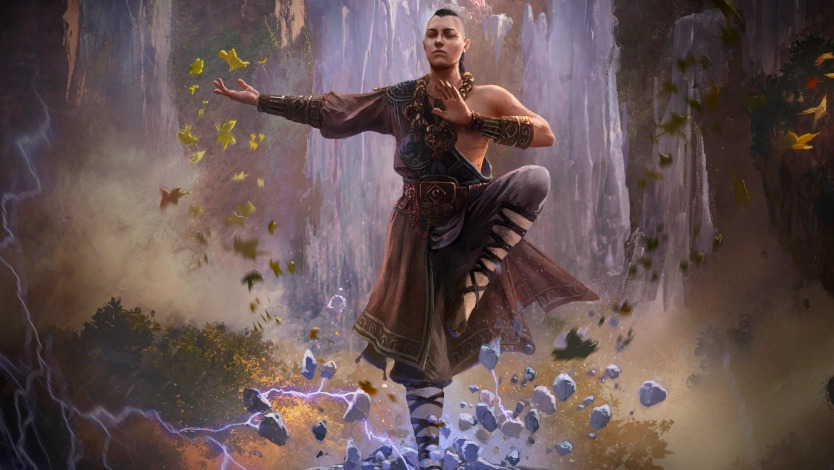
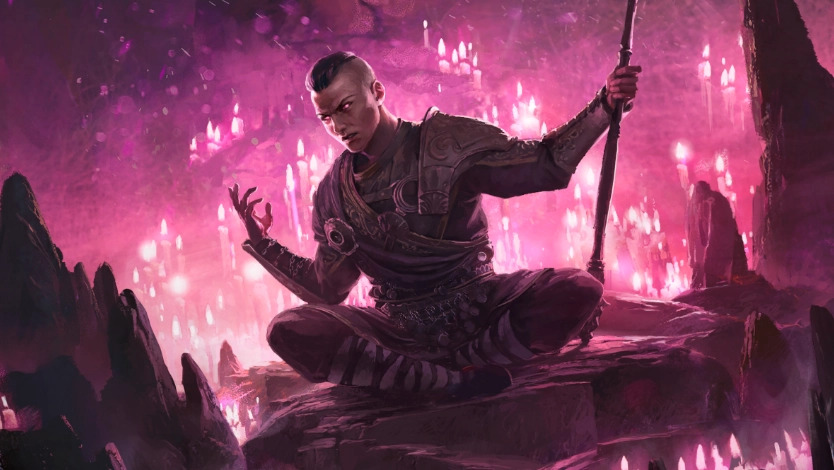
1. Invoker Ascendancy
The Invoker harnesses the elemental forces of Lightning, Ice, and Wind, using them to devastate enemies and control the battlefield. This Ascendancy rewards skillful use of combos to trigger powerful elemental effects and benefits players who enjoy high mobility and area-of-effect abilities.
Strengths:
- High AoE damage potential.
- Strong crowd control capabilities.
- Excellent mobility for engaging and evading enemies.
Weaknesses:
- Fragile without proper gear or defensive passives.
- Heavily reliant on mana for sustained ability use.
- Requires skillful execution of combos for maximum damage.
2. Acolyte of Chayula Ascendancy
The Acolyte of Chayula embodies a balance between physical and chaos damage, leveraging sacrificial mechanics to unleash devastating attacks while sustaining itself through life leech and chaos resistance. This Ascendancy is ideal for players who thrive on a high-risk, high-reward playstyle.
Strengths:
- Consistent hybrid damage output.
- High survivability through life leech and chaos immunity.
- Unique playstyle that rewards calculated risk-taking.
Weaknesses:
- Demanding resource management for health and mana.
- Relatively slow to scale until specific gear or passives are unlocked.
- Requires precise positioning and timing in combat.
SKIP THE GRIND BUY CHEAP POE 2 CURRENCY!
What is the best Monk Ascendancy?
The "best" Monk Ascendancy in Path of Exile 2 is subjective and influenced mainly by your personal playstyle and build objectives. To find your ideal Ascendancy, it's best to experiment with each option and identify which aligns most closely with your preferences and gameplay goals.
Choose Invoker If:
- You want a flashy, elemental-damage build.
- Mobility and AoE crowd control are important to you.
- You enjoy synergizing elemental effects like shock, chill, and stun.
Choose Acolyte of Chayula If:
- You prefer a balanced hybrid build with chaos damage.
- You are comfortable managing health or mana sacrifices for power.
- Survivability through life leech and chaos immunity appeals to you.
With the Monk’s Ascendancies outlined, it’s time to dive into the Passive Skill Tree, where you can further refine and enhance your build. Moving forward, we’ll explore the most effective paths to take, ensuring your Monk becomes a force to be reckoned with. Let’s chart the optimal course for your journey through the Passive Skill Tree!
Monk Passive Skill Tree
The Passive Skill Tree in Path of Exile 2 is a vast and intricate web of interconnected nodes forming the character progression's foundation. By strategically allocating Skill Points, you can customize your Monk’s abilities and attributes to suit your desired playstyle.
For the Monk class, the tree emphasizes agility, unarmed combat, attack speed, and chi-based mechanics. With access to both offensive and defensive nodes, the Monk’s starting position provides a strong foundation for a variety of builds, ranging from swift, evasive strikers to chi-powered juggernauts.
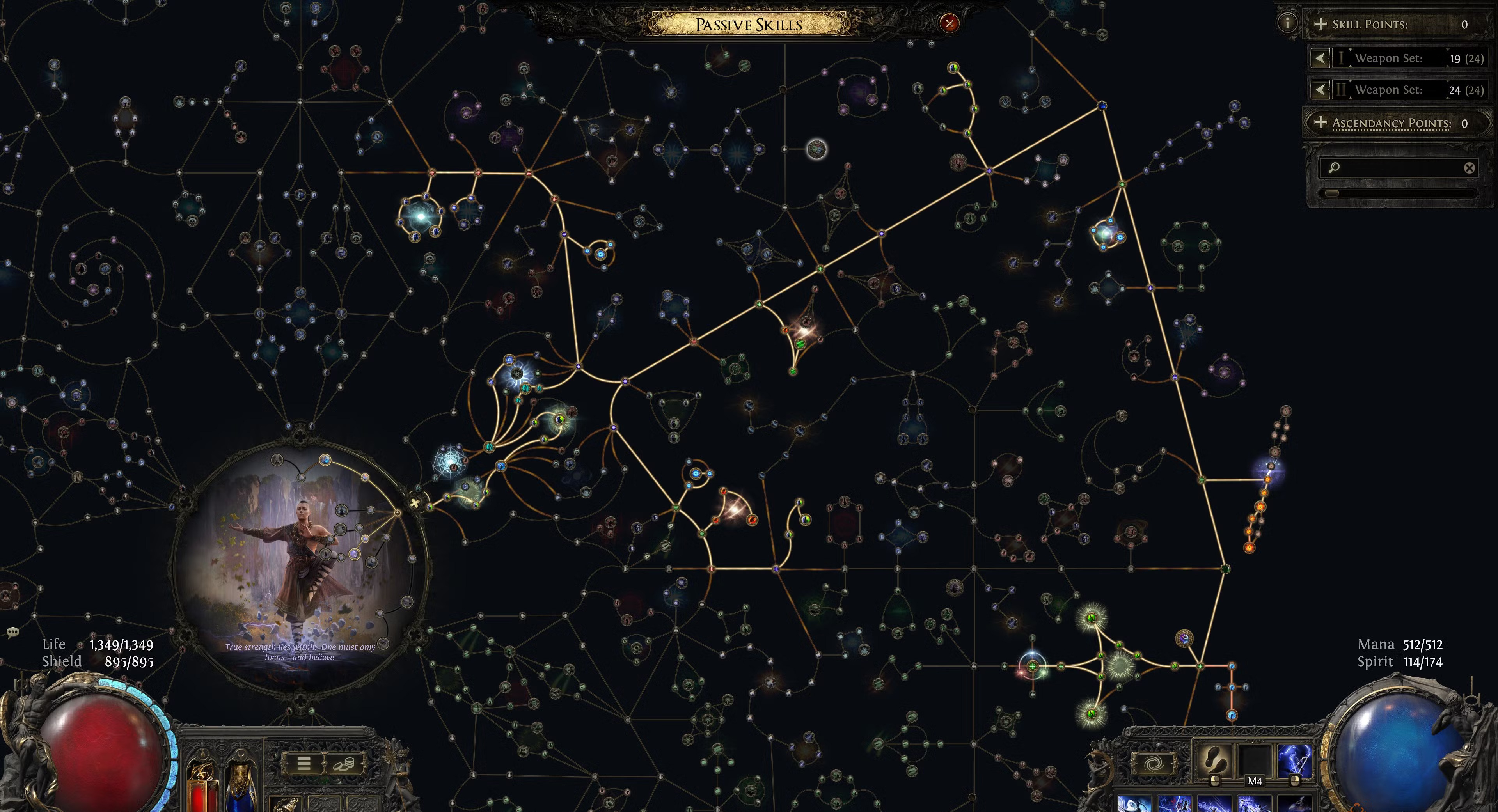
These nodes can be categorized into:
- 1. Attribute Nodes: These nodes grant choices between Strength, Dexterity, or Intelligence. For the Monk, Dexterity and intelligence are essential, with occasional benefits from Strength depending on the build.
- 2. Minor Nodes: These nodes provide small bonuses such as increased evasion, unarmed damage, or chi efficiency.
- 3. Notable Nodes: These nodes offer more significant bonuses and often include unique effects, such as improved regeneration or enhanced mobility.
- 4. Keystone Nodes: These are powerful, unique nodes that can dramatically change your Monk’s abilities. They often require specific conditions or investments to unlock their full potential.
Starting Location on the Passive Tree
The Monk begins in the Upper Right section of the Passive Skill Tree, aligning with its Intelligence and Dexterity focus. This starting position provides immediate access to nodes that enhance spellcasting abilities and agility, facilitating a hybrid playstyle that combines swift attacks with magical prowess.
The Monk's passive skill tree is tailored to enhance agility, attack speed, and unarmed damage while providing defensive options through evasion and resistance mechanics. It is interspersed with unique passive nodes that amplify the Monk's core mechanics, such as chi generation and enhanced unarmed combat capabilities.
A total of 122 Passive Skill Points can be allocated in the Passive Skill Tree, including those earned from optional Skill Books acquired through various in-game content. These points enable you to customize your character's abilities and attributes to match your preferred playstyle. Furthermore, Path of Exile 2 provides flexibility in character progression by allowing you to reallocate points anytime through the Hooded One NPC, making it easy to adapt or refine your build as you advance through the game.
Key Passive Nodes
In the following list, we present some key passive nodes that Monks should consider prioritizing:
- Conservative Casting: Reduces mana costs, allowing for more efficient skill usage.
- Killer Instinct: Increases critical strike chance and damage, boosting overall DPS.
- Flow Like Water: Enhances attack and movement speed, improving agility in combat.
- Step Like Mist: Provides increased evasion and energy shield, bolstering defenses.
- Essence of the Storm: Amplifies lightning damage, synergizing with the Monk's elemental skills.
- Immortal Infamy: Grants increased damage and critical strike multiplier, further enhancing offensive capabilities.
These passive nodes are strategically positioned near the Monk's starting area on the passive skill tree, facilitating efficient allocation of skill points to maximize the class's potential. By strategically allocating their passive skill points, Monks can become incredibly powerful melee combatants, capable of swiftly dispatching enemies with devastating combos and unmatched agility.
Best Monk Gems
In Path of Exile 2, gems play a crucial role in shaping your Monk's combat effectiveness, enhancing your abilities, and offering versatility to suit various playstyles. Monks excel at both agile, precise attacks and potent elemental magic. Gems help unlock unique skills and amplify their impact, allowing for both offensive and defensive synergies.
Below, we’ll present some of the best Skill Gems, Support Gems, and Spirit Gems for the Monk class in PoE2.
Best Monk Skill Gems
Skill Gems are essential components of a Monk's abilities in Path of Exile 2. These gems provide access to specific skills, from swift melee strikes to powerful elemental spells. Each Skill Gem has distinct properties, such as the type of damage (e.x. physical or elemental), attack range, area of effect, and mana cost. Skill Gems allow the Monk to perform specialized attacks, making them central to the Monk's versatile playstyle.
For both Ascendancies, the following Skill Gems are excellent choices for Monks in PoE2:
- Tempest Flurry - is a rapid melee attack that charges your staff with electrical energy, releasing shockwaves upon impact.
- Storm Wave - allows you to sweep your quarterstaff, projecting a bolt of lightning through the ground in a long wave ahead of you.
- Falling Thunder - infuses your quarterstaff with electrical energy, then slams the ground to deal damage in a large cone in front of you.
- Tempest Bell - A unique skill that creates a bell on the ground, dealing area damage and applying elemental ailments to enemies within its radius.
- Killing Palm - is an attack skill that allows the Monk to dash to an enemy and strike with an unarmed attack, dealing significant physical damage.
- Glacial Cascade - is a cold spell that launches a wave of icicles, dealing damage in a series of bursts along the ground.

Best Monk Support Gems
Support Gems are designed to enhance the effectiveness of Skill Gems, offering a wide array of beneficial modifiers when linked. These gems increase damage output, add secondary effects like freezing or burning, and even alter a skill's mechanics to fit specific needs. Strategic use of Support Gems is vital for maximizing the Monk’s damage potential, utility, and ability to tackle a variety of challenges effectively.
Below, we present the best choices of Support Gems for Monks in PoE2:
- Overabundance - Increases the number of combo stacks that can be built while the Tempest Bell is active, allowing for more powerful attacks.
- Leverage - Provides increased critical hit chance against immobilized enemies, such as those affected by the Freeze status.
- Supercritical - Boosts critical damage, enhancing the Monk's offensive capabilities.
- Heft - Increases physical damage, benefiting skills like Ice Strike that convert physical damage to cold.
- Martial Tempo - Accelerates the combo speed of skills, allowing for quicker execution of attacks.
- Cold Infusion - Converts a skill's damage to cold, making it ideal for cold-focused builds.
- Heightened Curse - Increases the effectiveness of curses, such as Hypothermia, which reduces enemies' cold resistance
Best Monk Spirit Gems
Spirit Gems offer passive benefits or conditional buffs that align with a Monk’s unique combat style. These gems provide ongoing enhancements such as increased damage, improved defense, enhanced mobility, or support for summoned allies. The careful management of Spirit Gems allows you to tailor your Monk's abilities further, making them an essential tool for improving overall performance in both offense and survival.
In the following list, you can find some of the top spirit gems to consider to use for Monk in PoE2:
- Herald of Thunder - grants additional lightning damage to your attacks and spells, making it ideal for Monks focusing on lightning-based skills.
- Herald of Ice - provides extra cold damage and causes shattering explosions upon freezing enemies, which is beneficial for crowd control and elemental damage builds.
- Lingering Illusion - enhances the duration of illusion-based skills, allowing summoned illusions to persist longer and deal sustained damage.
- Unbound Avatar - increases the effectiveness of your elemental auras, boosting both offensive and defensive capabilities.
Now that we’ve covered the best gems to maximize your Monk’s abilities, it’s time to explore the unique items that can further enhance your build. In the next section, we’ll delve into powerful gear options tailored to the Monk, helping you unlock their full potential. Let’s take a closer look at these game-changing items!
Best Monk Unique Items
Unique items are excellent tools that can greatly enhance your Monk’s abilities, granting divine effects and benefits unattainable with ordinary equipment. These rare artifacts are marked by their distinctive orange text and come imbued with a range of preordained modifiers.
Monks can obtain Unique Items in Path of Exile 2 through the following sacred paths:
- Boss Drops: Killing mighty bosses, particularly those of the endgame and unique variety, offers a significant chance to receive these exalted items as rewards for your triumph.
- Map Drops: Unique items may be discovered while clearing maps, dropping from rare and magical enemies, especially in high-level sanctuaries.
- Vendor Recipes: Monks can transform rare items and currency into unique relics by following specific vendor recipes.
- Orb of Chance: This rare currency can transform a humble item into a unique artifact. However, use it with care, as there is a chance the item could be destroyed if luck is not on your side.
In the following table, we present some of the best Unique Items for Monks along with their effects in Path of Exile 2:
| Unique Item | Effects |
| Pillar of the Caged God | This Long Quarterstaff scales damage based on your attributes, making it ideal for Monks who invest heavily in Dexterity, and Intelligence. |
| Collapsing Horizon | A unique Wyrm Quarterstaff that enhances elemental damage and critical hit chance, beneficial for elemental-focused Monk builds. |
| Atsak's Sight | A unique Veiled Mask that increases critical hit chance and grants poison on critical hits, suitable for Monks utilizing poison mechanics. |
| Idle Hands | Sectioned Bracers that boosts attack speed when mana is nearly full, complementing fast-paced combat styles. |
| Bitterbloom | A unique Feathered Robe that enhances energy shield and mana, improving survivability and resource management. |
| Hand of Wisdom and Action | Unique Gloves that converts attribute points into lightning damage, ideal for Monks focusing on dexterity and intelligence. |
| Sandstorm Visage | Unique Chain Tiara that provides energy shield and blinds nearby enemies, enhancing defense. |
Now that we've explored the unique items that can elevate your Monk's potential, it's time to shift our focus to practical advice for improving your gameplay. In the next section, we'll dive into essential tips and tricks to help you level up faster, optimize your progression, and overcome challenges more efficiently as you advance through Path of Exile 2. Let’s get started!
Monk Leveling Tips
Leveling a Monk in Path of Exile 2 demands careful planning and thoughtful use of resources to ensure a seamless journey. In the following sections, we present some key tips to optimize your leveling experience:
1. Complete the campaign & complete all side objectives
Fully immersing yourself in the main campaign and tackling side quests will grant you valuable experience points, gear, and currency. Side quests often reward skill points or passive bonuses, which are vital for the Monk's progression and build flexibility.
Furthermore, completing these objectives can unlock access to Uncut Gems and other essential resources that enhance your character's effectiveness. By dedicating time to these tasks, you'll gain a significant edge in leveling efficiency and overall power.

2. Always out-level the zone
Keeping your character's level at or slightly above the area's level is essential for smooth progression in Path of Exile 2. This ensures enemies are easier to handle and allows you to equip gear suited to your level, making gameplay more seamless.
If you're under-leveled, revisit earlier areas to farm experience or complete extra side quests to catch up. Being slightly over-leveled lets you clear zones quickly and gather loot more efficiently, especially during the early stages of the game.
3. Check the vendors on level up
Check vendors regularly after each level-up, as their inventories update with items suited to your current level. This approach can significantly boost your damage and survivability. Vendors offer a range of items, including gear, gems, and crafting materials, making it valuable to browse for potential upgrades.
4. Spend currency to craft on gear pieces
Crafting is an effective method for upgrading your gear, allowing you to create custom items with specific enchantments and modifiers by using currency on crafting materials. By utilizing currencies such as Orbs of Transmutation, Orbs of Augmentation, and Essences, you can customize your equipment to match your playstyle, enhance your character’s performance, and address gaps in your gear, such as adding resistances or increasing damage.
5. Pick up all magic, rare, and unique gear pieces and identify them to check for upgrades
Always collect magic, rare, and unique items, and identify them to evaluate potential upgrades. This not only helps you discover gear that improves your build but also familiarizes you with valuable attributes. Even if an item isn’t immediately useful, it can be sold for currency or used in crafting recipes. Unique items, in particular, often have powerful effects that can significantly enhance your character’s strength and distinguish your build.
6. Upgrade you skills and add supports using Uncut Gems you find
As you advance in the game, you'll obtain Uncut Gems, which are vital for acquiring new skills or enhancing existing ones with support gems. Upgrading your primary attack skills and pairing them with suitable supports can greatly increase your damage and effectiveness. Skill points also allow you to unlock and improve abilities, so try out different combinations of skills and supports to find the setup that best suits your playstyle.
By following these tips, you’ll build a strong foundation for your Monk, making the leveling process smoother and more enjoyable. Remember, adaptability and regularly improving your gear and skills are crucial to overcoming the challenges of Path of Exile 2.
With a solid understanding of the Monk’s strengths and key mechanics, it’s time to implement that knowledge. Next, we’ll introduce a beginner-friendly starter build designed to streamline your leveling process and get your Monk up to speed quickly. Let’s dive into the essentials of crafting a powerful and efficient early-game build!
Monk League Starter Build
The Monk is an excellent choice for starting a new league in Path of Exile 2, providing a balanced foundation for early-game progression and versatile build options. With a focus on agility, adaptability, and self-sustain, the Monk excels at clearing content efficiently while scaling into powerful and flexible setups.
This section offers a beginner-friendly build designed to balance offense and defense, ensuring steady damage output and durability. It includes detailed guidance on skill selections, gem links, gear recommendations, and other essential tips to navigate early Wraeclast and set your character up for success.
| Skill Gems | Support Gems |
| Tempest Furry | Electrocute Rage Martial Tempo |
| Charged Staff | Persistence Innervate Primal Armament |
| Storm Wave | Cold Infusion Ice Bite |
| Tempest Bell | Concentrated Effect
Overabundance |
| Falling Thunder |
Perpetual Charge Ricochet Longshot |
| Herald of Ice (Buff) | Magnified Effect |
| Combat Frenzy (Buff) | Profusion |
| Wind Dancer (Buff) |
Pin Lockdown |
| Herald of Thunder (Buff) |
Blind Maim |
This Monk build gradually becomes more powerful, reaching its full potential by Act 3. Early in the game, you will rely on a mix of skills to navigate the campaign effectively until you unlock the ideal setup. The core strategy focuses on rapid attacks combined with Tempest Bell, which is placed on bosses to deal significant damage.
In Act 1, Killing Palm and Falling Thunder clear enemy packs easily by stacking Power Charges to wipe out groups efficiently. For bosses, Glacial Cascade provides safe, ranged damage that makes tougher fights manageable. After defeating the Executioner, you can return to the Clearfell Encampment to obtain your first Rank 5 Skill Gem, Ice Strike. Pairing Ice Strike with Tempest Bell results in substantial single-target damage, making it an excellent choice for taking down the Act 1 boss.
In Act 2, you unlock your first Rank 7 Skill Gem, Storm Wave, which becomes a powerful tool for clearing large areas. This skill allows you to handle the more difficult zones of Act 2 from a safe distance. Meanwhile, Tempest Flurry and Tempest Bell remain key for dealing with bosses efficiently. This build progression ensures smooth gameplay, with powerful skills coming online at critical points to dominate both enemies and bosses.
Now that you’ve become proficient with your skills during the leveling journey, it’s time to focus on the Passive Skill Tree. The following image will help you choose the best nodes to boost your Monk’s power, ensuring a smooth transition into a strong and well-optimized build.

Once you're familiar with the Passive Skill Tree, the next step is equipping your Monk with the right items. This table outlines essential gear choices and recommended affixes to maximize your build's effectiveness, ensuring a strong balance of offense and defense for a smooth start.
| Equipment | Affixes |
| Slicing Quarterstaff |
|
| Body Armor |
|
| Helmet |
|
| Gloves |
|
| Boots |
|
| Belt |
|
| Rings |
|
| Amulets |
|
With your starter build set up, you're ready to take your Monk to the next level. Next, we'll dive into advanced tips and strategies for optimizing your endgame performance, tackling tougher content, and refining your build for maximum efficiency and power.
Pro Monk Endgame Tips & Tricks
Mastering the Monk in the endgame of Path of Exile 2 requires strategic planning, effective gearing, and refined gameplay. Reaching this stage takes dedication and a strong grasp of the game’s mechanics.
The following sections provide advanced strategies to help you transition into an optimized endgame build, manage your currency efficiently, and conquer the game’s most challenging content. From progressing through the Atlas of Worlds to defeating pinnacle bosses, you'll find guidance on build refinement, gear upgrades, and tackling challenging encounters. With these tips, you’ll unlock your Monk’s full potential and excel in Wraeclast's endgame.
1. Transitioning into an endgame build with useful stats and capped resistances
Transitioning into an endgame build is essential for surviving more demanding challenges and maximizing your Monk’s performance. Focus on acquiring gear with strong defensive stats, such as high life, armor, and energy shield (if hybrid), along with capped elemental resistances of 75% or higher. Chaos resistance becomes increasingly important in endgame content, so prioritize it when possible. For weapons, look for high base damage, attack speed, and modifiers like increased physical damage or added elemental damage to boost your effectiveness.
In addition to upgrading your gear, revisit your passive skill tree to ensure your point allocation aligns with your chosen playstyle—whether as a durable tank, a high-damage dealer, or a balanced hybrid. Use Gold to refund passive skill points if necessary, but always prioritize survivability and utility before focusing on damage scaling for endgame challenges.
As you advance, having a well-optimized build becomes critical. Select an Ascendancy class that complements your preferred playstyle and allocate attribute points thoughtfully. Use the passive skill tree to invest in nodes that enhance your damage type, defensive capabilities, and other key stats. By fine-tuning your gear, passive tree, and resistances, you’ll ensure your Monk is ready to tackle the endgame with confidence.
2. Constantly use your currency to craft or buy upgrades for your gear
Currency is the cornerstone of endgame progression, and managing it effectively is key to crafting powerful gear with ideal enchantments and modifiers. The crafting system in Path of Exile 2 provides extensive customization options, allowing you to tailor your equipment to suit your specific needs.
Utilize the in-game currency exchange feature to convert less useful items, such as Chaos Orbs, into more valuable ones like Exalted Orbs, or the reverse as needed. Monitor exchange rate fluctuations and trade strategically to maximize your resources. Keeping liquid currency on hand ensures you can act quickly when valuable upgrades become available on the market.
3. Use the Path of Exile Trade website to look for possible upgrades using filters
The Path of Exile Trade website is an essential resource for finding gear tailored to your build and comparing prices. Use the search filters to refine your options based on criteria like item level, quality, and specific modifiers such as +X% to Maximum Life, increased Physical Damage, or increased Attack Speed.
Include resistance caps in your search to address defensive needs, and set price ranges to avoid overspending. Sorting items by cost-to-value ratio helps you make budget-friendly upgrades. Save your searches or tweak the filters as your build evolves to identify the best upgrades quickly. This ensures you efficiently stay ahead and improve your gear without unnecessary delays.
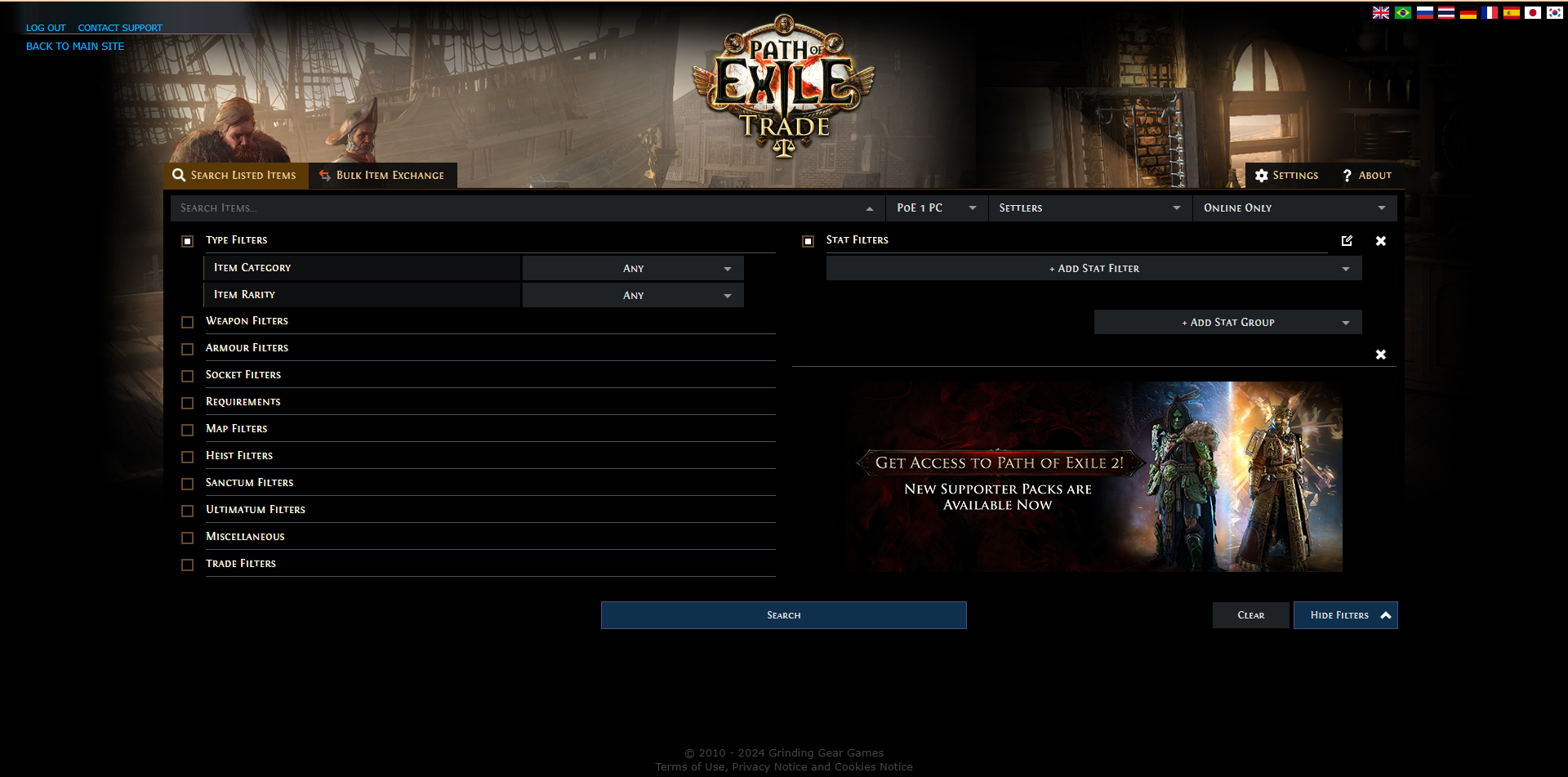
4. Use the in-game currency exchange feature for fast currency trading
Efficient currency trading is crucial for staying competitive in the endgame as a Monk in Path of Exile 2. Use the in-game currency exchange feature to convert less-used currency into higher-value items, enabling you to acquire specific currencies or sell excess for profit.
Monitor exchange rate fluctuations to trade at the best times and maintain a reserve of liquid currency to act quickly when valuable upgrades become available on the market. This adaptability is essential for optimizing your build and obtaining powerful gear for your Monk.
5. Complete the 3rd and 4th Ascension Trials for additional Ascendancy Passive Points
Completing the 3rd and 4th Ascension Trials is an important milestone for your Monk, unlocking valuable Ascendancy Passive Points that greatly improve your build’s power. These points allow you to specialize further, providing powerful bonuses like increased damage, survivability, or utility.
Before attempting these trials, make sure your gear and resistances are prepared for the increased difficulty. Take time to practice the traps and boss mechanics to reduce unnecessary deaths. The extra Ascendancy passives can be game-changing, solidifying your Monk's role and enhancing your build’s stability and effectiveness in the endgame.
SKIP THE GRIND GET CHEAP POE 2 SERVICES!
6. Progress through the atlas avoiding difficult waystone modifiers
The Atlas of Worlds is a key aspect of your endgame journey in Path of Exile 2, allowing you to shape your progression as a Monk. To ensure smooth progress and avoid frustration, focus on clearing maps that match your current power level. Avoid challenging Waystone modifiers, such as increased monster damage or reduced player regeneration, until your character is stronger.
Be mindful of map modifiers before running them, particularly for more challenging encounters. If necessary, skip Waystones with complex modifiers or trade for safer maps. Complete map objectives like league mechanics or pinnacle bosses to unlock higher-tier maps, prioritizing those that complement your build’s strengths while minimizing unnecessary risks.
7. Clear maps of an adequate tier based on your level
Clearing maps that match your Monk's level and gear strength is crucial for efficient leveling and gear acquisition. Focus on maps within 1-2 tiers of your comfort zone to ensure steady experience gain without taking on too much risk. Jumping into high-tier maps too early can lead to unnecessary deaths, frustration, and experience loss.
As your build improves with better gear and capped resistances, gradually progress into red-tier maps for more challenging content. This strategic approach ensures smoother progression, allowing you to tackle tougher maps when you’re fully prepared.
8. Play safe and avoid dying at any cost
Surviving the endgame is just as vital as dealing damage, as higher-level death penalties can significantly slow your progress. Play carefully by keeping your flasks topped off, maintaining good positioning, and learning the mechanics of difficult bosses.
Invest in defensive layers like block chance, fortify effects, or life recovery on hit to mitigate incoming damage. Also, always carry a mobility skill to help with escapes. Playing safely ensures steady progress through Path of Exile's most challenging content.
FAQs – POE2 Monk Class Overview
Is Monk a good class in Path of Exile 2?
Yes, the Monk is a strong and versatile class offering a good balance of offense and defense, making it suitable for various playstyles.
Is Monk easy to play?
Monks are relatively easy to pick up, but mastering their skill synergies and positioning can take practice.
What are the best stats for Monk in Path of Exile 2?
The best stats for Monk in PoE2 are Intelligence and Dexterity.
What is the stats priority for Monk?
Prioritize Int > Dex > Str and other secondary stats, depending on the build.
Is Monk good for speedfarming maps?
Yes, Monks are excellent for speedfarming thanks to their high mobility and rapid attack abilities.
Is Monk good for pinnacle bosses?
Monks can be effective against pinnacle bosses with proper builds, especially those focused on sustained damage and mobility.
Conclusion
The Monk class in Path of Exile 2 represents a harmonious blend of martial prowess and spiritual focus, offering a unique gameplay experience for players who enjoy a dynamic and adaptable playstyle. By combining precise melee techniques with strategic resource management, the Monk excels at both rapid damage output and survivability in high-stakes combat.
By reading our guide and prioritizing proper stat allocation, selecting the best gems, choosing an optimal path on the skill tree, and progressing strategically through the game’s challenges, you can shape your Monk into a formidable endgame character capable of conquering even the toughest content.
Mastering the Monk requires dedication and understanding its unique mechanics, but the rewards are well worth the effort. With its unparalleled fluidity and satisfying gameplay, the Monk is an excellent choice for players seeking both challenge and creativity in their Path of Exile 2 journey.
Related Guides
Stay tuned and check out our related guides for Path of Exile 2:
- Path of Exile 2 Leveling Guide
- Path of Exile 2 Currency Guide
- Path of Exile 2 Best Classes Guide
- Path of Exile 2 Gearing Guide
- Path of Exile 2 Beginner Guide
- Path of Exile 2 Trading Guide
- Path of Exile 2 Crafting Guide
- PoE 2 Mercenary Guide – Complete Class Overview
- PoE 2 Warrior Guide – Complete Class Overview
- PoE 2 Witch Guide – Complete Class Overview
- PoE 2 Sorceress Guide – Complete Class Overview
About KBoosting
Thank you for taking the time to read our guide about Monk Class in Path of Exile 2. Did you know that at KBoosting, we are not only about guides and articles? We also provide boosting services to make things even easier for you. Check out our PoE2 boosting services, let us handle everything for you, while you have some real fun in the game!




